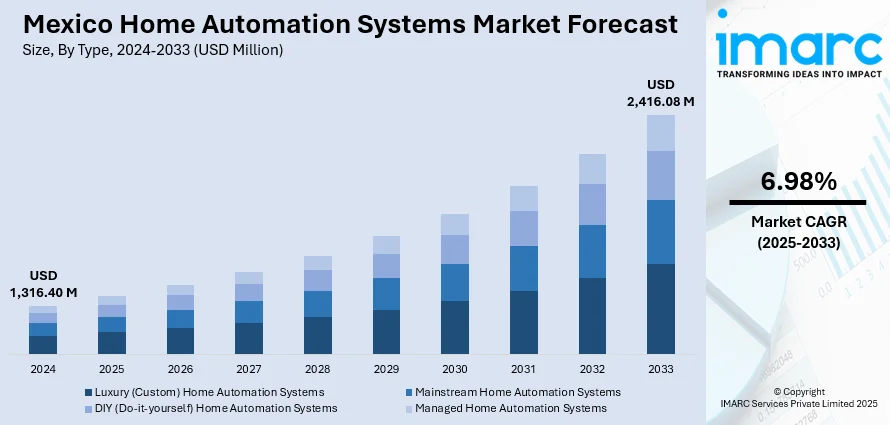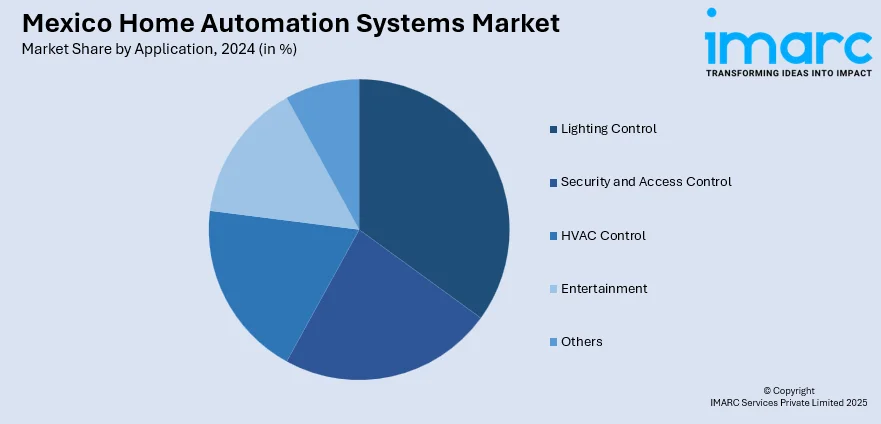
Mexico Home Automation Systems Market Size, Share, Trends and Forecast by Type, Application, and Region, 2025-2033
Mexico Home Automation Systems Market Overview:
The Mexico home automation systems market size reached USD 1,316.40 Million in 2024. Looking forward, IMARC Group expects the market to reach USD 2,416.08 Million by 2033, exhibiting a growth rate (CAGR) of 6.98% during 2025-2033. The market is witnessing significant growth due to rising consumer interest in smart home technologies. Increasing disposable incomes, growing demand for energy-efficient solutions, and advancements in Internet of Things (IoT) technology are driving market expansion. As urbanization continues to rise, consumers are prioritizing convenience and security, which further contributes to the overall Mexico home automation systems market share.
|
Report Attribute
|
Key Statistics
|
|---|---|
|
Base Year
|
2024 |
|
Forecast Years
|
2025-2033
|
|
Historical Years
|
2019-2024
|
| Market Size in 2024 | USD 1,316.40 Million |
| Market Forecast in 2033 | USD 2,416.08 Million |
| Market Growth Rate 2025-2033 | 6.98% |
Mexico Home Automation Systems Market Trends:
Rising Adoption of Smart Security Systems
The use of smart security systems is increasing at a fast pace in Mexico prompted by increasing security concerns about homes and the need for improved convenience. Consumers are increasingly buying smart products such as surveillance cameras, video doorbells, motion sensors, and alarm systems that can be accessed remotely using mobile apps. These systems ensure real-time monitoring, immediate alerts, and access to view footage anywhere giving homeowners a sense of security. Moreover, smart security solutions tend to integrate with other home automation technologies including lighting and climate control enabling users to define personalized security settings. This trend is especially popular in metropolitan towns as the need for sophisticated security features is increasing there. As security technologies continue to advance, more advanced solutions, such as facial recognition and artificial intelligence-powered surveillance are poised to become increasingly popular in the Mexican market.

Growing Demand for Voice-Controlled Systems
Voice-controlled systems are gaining wider acceptance in Mexico's home automation industry providing users with an easy and hands-free solution for controlling a range of smart home appliances. Voice assistants such as Amazon Alexa, Google Assistant, and Apple Siri are extensively used in home automation solutions enabling users to operate lighting, temperature, security, entertainment systems, and other features with mere voice commands. This convenience and ease of operation have pushed demand particularly among technology-conscious consumers who seek easy-to-use and time-efficient solutions. Additionally, the systems are multilanguage-capable, with Spanish being among the supported languages addressing Mexico's multicultural population. As voice recognition advances further, voice control incorporation into daily home operations is likely to increase, smarter and more efficient homes waiting in the wings. This development will most probably accelerate the use of smart home technology, since voice-operated systems promote convenience and accessibility for a large audience.
Integration of Mobile Apps
Mobile app integration is a primary driver of Mexico's home automation market growth. Mobile applications are increasingly being used to remotely control and monitor home automation systems, bringing an added convenience and flexibility to daily existence. With the touch of a button, users can control lighting, security systems, climate control, and entertainment devices from almost anywhere. This access ease comes in particularly handy for tech-savvy individuals and working professionals who look for convenience and efficiency. Real-time alerts are also made possible by mobile apps, which give users immediate notification of security issues or maintenance problems. Most apps also provide customization options, wherein homeowners can design automated routines in accordance with their preferences. As smartphones become more integrated into people’s lives, the use of mobile applications to control home automation systems is expected to grow, further driving the Mexico home automation market growth.
Mexico Home Automation Systems Market Segmentation:
IMARC Group provides an analysis of the key trends in each segment of the market, along with forecasts at the country and regional levels for 2025-2033. Our report has categorized the market based on type and application.
Type Insights:
- Luxury (Custom) Home Automation Systems
- Mainstream Home Automation Systems
- DIY (Do-it-yourself) Home Automation Systems
- Managed Home Automation Systems
The report has provided a detailed breakup and analysis of the market based on the type. This includes luxury (custom) home automation systems, mainstream home automation systems, DIY (do-it-yourself) home automation systems, and managed home automation systems.
Application Insights:

- Lighting Control
- Security and Access Control
- HVAC Control
- Entertainment
- Others
A detailed breakup and analysis of the market based on the application have also been provided in the report. This includes lighting control, security and access control, HVAC control, entertainment, and others.
Regional Insights:
- Northern Mexico
- Central Mexico
- Southern Mexico
- Others
The report has also provided a comprehensive analysis of all the major regional markets, which include Northern Mexico, Central Mexico, Southern Mexico, and others.
Competitive Landscape:
The market research report has also provided a comprehensive analysis of the competitive landscape. Competitive analysis such as market structure, key player positioning, top winning strategies, competitive dashboard, and company evaluation quadrant has been covered in the report. Also, detailed profiles of all major companies have been provided.
Mexico Home Automation Systems Market Report Coverage:
| Report Features | Details |
|---|---|
| Base Year of the Analysis | 2024 |
| Historical Period | 2019-2024 |
| Forecast Period | 2025-2033 |
| Units | Million USD |
| Scope of the Report | Exploration of Historical Trends and Market Outlook, Industry Catalysts and Challenges, Segment-Wise Historical and Future Market Assessment:
|
| Types Covered | Luxury (Custom) Home Automation Systems, Mainstream Home Automation Systems, DIY (Do-it-yourself) Home Automation Systems, Managed Home Automation Systems |
| Applications Covered | Lighting Control, Security and Access Control, HVAC Control, Entertainment, Others |
| Regions Covered | Northern Mexico, Central Mexico, Southern Mexico, Others |
| Customization Scope | 10% Free Customization |
| Post-Sale Analyst Support | 10-12 Weeks |
| Delivery Format | PDF and Excel through Email (We can also provide the editable version of the report in PPT/Word format on special request) |
Key Questions Answered in This Report:
- How has the Mexico home automation systems market performed so far and how will it perform in the coming years?
- What is the breakup of the Mexico home automation systems market on the basis of type?
- What is the breakup of the Mexico home automation systems market on the basis of application?
- What is the breakup of the Mexico home automation systems market on the basis of region?
- What are the various stages in the value chain of the Mexico home automation systems market?
- What are the key driving factors and challenges in the Mexico home automation systems market?
- What is the structure of the Mexico home automation systems market and who are the key players?
- What is the degree of competition in the Mexico home automation systems market?
Key Benefits for Stakeholders:
- IMARC’s industry report offers a comprehensive quantitative analysis of various market segments, historical and current market trends, market forecasts, and dynamics of the Mexico home automation systems market from 2019-2033.
- The research report provides the latest information on the market drivers, challenges, and opportunities in the Mexico home automation systems market.
- Porter's five forces analysis assist stakeholders in assessing the impact of new entrants, competitive rivalry, supplier power, buyer power, and the threat of substitution. It helps stakeholders to analyze the level of competition within the Mexico home automation systems industry and its attractiveness.
- Competitive landscape allows stakeholders to understand their competitive environment and provides an insight into the current positions of key players in the market.
Need more help?
- Speak to our experienced analysts for insights on the current market scenarios.
- Include additional segments and countries to customize the report as per your requirement.
- Gain an unparalleled competitive advantage in your domain by understanding how to utilize the report and positively impacting your operations and revenue.
- For further assistance, please connect with our analysts.
 Request Customization
Request Customization
 Speak to an Analyst
Speak to an Analyst
 Request Brochure
Request Brochure
 Inquire Before Buying
Inquire Before Buying




.webp)




.webp)












